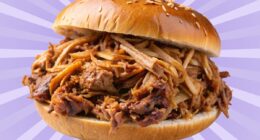Although the BRAT diet has been viewed as the proper treatment for how to stop diarrhea for many years, it has recently been deemed too restrictive by the American Academy of Pediatrics. This left many people wondering: What foods make your stomach feel better?
BRAT diet foods are consumed after diarrhea and vomiting because they are easy on the digestive system. These diarrhea diet foods work as stomachache remedies because they are bland and give the stomach a chance to rest.
However, sticking to a BRAT diet menu alone lacks vital nutrients that the body needs to get well, and this can lead to an electrolyte imbalance and malnourishment if it’s followed for too many days.
The key to eating when suffering from diarrhea is to choose nutrient-rich foods that add bulk to stool and help the body absorb vitamins and minerals.
What Is the BRAT Diet?
BRAT stands for bananas, rice, applesauce and toast. These are the foods you can eat on the BRAT diet, because they are meant to promote stomach pain relief.
Ad

Pediatricians sometimes suggest the BRAT diet for babies and kids with upset stomachs because they reduce the amount of stool produced by the body and give the gut a chance to rest.
Although the BRAT diet was a staple of most pediatricians’ recommendations for children with diarrhea, the American Academy of Pediatrics now recommends that kids resume eating a normal, well-balanced diet within 24 hours of diarrhea symptoms, because BRAT diet foods are low in fiber, protein and fat, thereby lacking enough nutrients.
How to Follow It
The BRAT diet is made up of foods that make your stomach feel better when dealing with issues like indigestion, diarrhea and vomiting. To follow the BRAT diet, you simply stick to foods that are easy to digest, but it’s also important to opt for nutrient-dense foods that boost your immune system and help you get well.
If you’re wondering what to eat after the BRAT diet, the answer is to slowly bring in a range of nutrient-rich and anti-inflammatory foods that nourish the body.
What You Can Eat
As mentioned, the BRAT diet food list calls for bananas, rice, applesauce and toast. However, research suggests that there are a variety of foods and drinks that are also effective.
What else can you eat on the BRAT diet? The following nutrient-dense foods are easy on the digestive system and help with nutrient absorption, boosting your immune system, and keeping you energized and hydrated.
1. Bone Broth
Bone broth is a BRAT diet alternative that’s rich in vital nutrients that support your gut and immune system. It helps with the growth of probiotics in the gut and supports healthy inflammation levels in the digestive system.
It’s also easily digested and soothes the digestive system, making it the perfect food for when you have diarrhea.
By using the healing power of bone broth, you ensure that you get the nutrients you need to get well. Because it’s in liquid form, it’s easy on the stomach and doesn’t have to be broken down.
You can use protein powder made from bone broth to make preparing this nutrient-rich food as easy as possible.
2. Probiotic Foods
Probiotic foods and supplements have been extensively studied in the prevention and treatment of diarrheal diseases, especially for children. According to research published in the Journal of Clinical Gastroenterology, the vast majority of published trials show a statistically significant benefit of probiotic strains, mostly Lactobacillus GG and S. boulardii, in the treatment of diarrhea.
On average, probiotics were able to reduce the duration of diarrhea by approximately one day in study participants. They help by providing the body with food bacteria and fighting off infections and other causes of diarrhea.
Further research concluded: “In the treatment of acute diarrhea in children, the addition of probiotics can shorten the duration of diarrhea, increase treatment efficacy after 2 days of treatment, and shorten the length of hospital stay.” However, the researchers cautioned more high-quality studies are needed to verify these findings.
The greatest probiotic foods that help relieve diarrhea and other digestive issues include cultured vegetables (like sauerkraut and kimchi), kombucha, natto, apple cider vinegar, miso and yogurt. It’s true that processed, conventional dairy can be hard to digest and make diarrhea worse, but raw, cultured dairy like yogurt is high in probiotics and can support bowel function.
3. Oats
Soluble fiber can absorb excess fluid in the bowels and add bulk to loose stools. Oats are gluten-free and high in soluble fiber.
Ad

They help firm up stool and sweep through the digestive tract, pulling toxins and waste along with them. It’s helpful to soak oats overnight, which reduces antinutrients and enzymes that can disturb nutrient absorption and digestion.
Research suggests that bulking agents like oat bran can be employed as natural diarrhea remedies.
4. Bananas
Bananas are easily digested, which is why they’re part of the BRAT diet. The high level of potassium in banana nutrition helps replace lost electrolytes, which is important when the body loses fluids and nutrients because of diarrhea.
Research has found that unripe, green bananas are beneficial when you have diarrhea.
Green bananas contain digestive-resistant starches that feed healthy bacteria in the gut. They don’t make you gassy, and they help add bulk to your stool.
A 2001 study published in Gastroenterology found that a rice-based diet containing cooked green bananas significantly reduced the amounts of stool in infants with diarrhea and reduced diarrheal duration.
To cook green bananas, simply place bananas, water and salt in a pot, and bring to a boil. Then reduce the heat, and let simmer for five minutes until the bananas are tender.
Drain the water, and eat the bananas plain or with another food for diarrhea, like oatmeal.
5. Vegetable Juice (with Carrots and Other Root Vegetables)
When you have diarrhea, it’s important that you eat enough nutrients in order to boost your immune system and allow your body to recover. That’s why the BRAT diet isn’t recommended for more than a 24-hour period.
Drinking vegetable juices that provide a range of vital vitamins and minerals can be beneficial, but it’s important that you use vegetables that won’t worsen your diarrhea symptoms.
Root vegetables are healing foods, and they can soothe the digestive system. Combine diarrhea foods like carrots, celery, spinach and ginger.
They all provide alkaline minerals and can help nourish the intestines and remove toxins from the body.
READ RELATED: This 4-Ingredient Vegan Mexican Horchata Recipe Is As Soothing for the Soul as It Is Delicious
Carrot juice, for example, provides vitamins A, C, D, E and K, as well as many minerals, such as magnesium, potassium and calcium. It has a high fiber content and helps add bulk to your stool while calming your digestive system.
It also has an absorbent power and does not diminish the intestinal loss of water and electrolytes.

6. Sweet Potatoes
If you’re looking for foods that help stop diarrhea, stock up on sweet potatoes. According to research published in the Journal of Medicinal Food, the sweet potato is an extremely versatile vegetable that possesses high nutritional value.
Sweet potato nutrition has strong anti-inflammatory properties and is packed with potassium, vitamin A, vitamin C and vitamin B6.
Sweet potatoes are more nutritious than white potatoes, and they still provide insoluble fiber, helping firm up stool and reduce the symptoms of diarrhea. Compared to white potatoes, sweet potatoes have a lower score on the glycemic index, so your body is thought to absorb their sugar at a slower pace.
If you find that sweet potatoes don’t help add bulk to stool and provide the body with energy, try white potatoes, which contain more starch.
7. Flaxseed Oil
Flaxseed oil benefits the digestive system in multiple ways. In fact, it can help relieve both constipation and diarrhea.
A 2015 study found that flaxseed oil was able to reduce the castor oil-induced diarrheal score of mice by 84 percent and intestinal secretions by 33 percent. Flaxseed oil is one of the richest sources of vegetable-based, vital omega-3 fatty acids, so it helps keep your body well-nourished while it fights inflammation and boosts your immune system.
8. Ginger
Ginger has been used for thousands of years as an effective digestive aid, making it an excellent food for upset stomach and diarrhea. Although ginger is more commonly known for its ability to ease nausea and vomiting, studies show that it can effectively inhibit diarrhea as well.
Research shows that ginger health benefits also include its ability to prevent the spread of bacteria that may lead to diarrhea in the first place. Eating whole ginger, drinking fresh ginger juice and inhaling diffused ginger essential oil are all highly effective ways to curb stomach ailments.
9. Water
Research shows that dehydration is a major complication associated with diarrhea. Mild and severe diarrhea can result in the loss of dangerously large amounts of fluids.
If you have diarrhea, drink enough liquids to keep your urine looking clear — that’s about eight to 10 glasses of water a day. A helpful rule of thumb is to drink at least one glass of water every time you have a loose bowel movement.
Evidence suggests that for infants and children with diarrhea, breastfeeding reduces the risk of dehydration, and it’s important to discourage drinking fruit juices and carbonated drinks, because they can increase the risk of dehydration.
10. Peppermint Oil
Peppermint oil can reduce bowel inflammation and soothe the digestive tract, reducing loose stools. It also has a cooling sensation and calming effect on the body.
It soothes the gastric lining and colon because of its ability to reduce muscle spasms. Studies show that peppermint oil is effective in relieving abdominal pain in people with diarrhea because of its antispasmodic properties.
Foods to Avoid
When you have diarrhea, you want to avoid foods that are going to aggravate your symptoms and stay nourished so you can recover quickly. There are some foods to avoid when looking for natural remedies for indigestion, diarrhea and chronic nausea.
If you suffer from chronic diarrhea, you may benefit from following an elimination diet that involves avoiding certain trigger foods, like gluten, dairy and soy, for three to six weeks. Then you slowly bring these foods back into your diet to see how your body reacts to each food group.
Other foods to avoid when dealing with upset stomach and diarrhea include the following:
- Foods containing refined sugars
- Artificial sweeteners
- Processed fats and oils
- Processed and packaged foods
- Alcohol
- Caffeine
- Peanuts
- Corn
- Eggs
- Certain nightshades
- Shellfish
How BRAT Works (Potential Benefits)
What is the BRAT diet used for? Eating bananas, rice, applesauce and toast as part of this diet for diarrhea is really intended to reduce the work being placed on your digestive system.
The reasoning behind the BRAT diet is that it includes binding foods that are low in fiber and can help to make stool firmer. It also includes bananas that are rich in potassium and help replace nutrients that are lost due to vomiting or diarrhea.
People follow the BRAT diet to help their bodies ease back into normal eating after having diarrhea or upset stomach.
Although it was believed that BRAT diet foods that stop diarrhea were best, it turns out that the best foods to eat when you have diarrhea aren’t necessarily part of a bland diet. Adding ginger, sweet potatoes, bone broth and carrot juice to your diet can help get rid of indigestion and upset stomach, while also providing important nutrients that the body needs to recover.
Some people may feel like they can only tolerate bland foods when they are nauseous or have diarrhea, so sticking to the BRAT diet for toddlers and adults is fine for the first 24 hours or so. After that, once you or your child is able to tolerate more foods, sticking to more nutrient-dense options is recommended.
There are some benefits to eating the BRAT diet list and other bland foods, including that they are:
Is It Effective and Safe? (Risks and Side Effects)
The BRAT diet is safe and effective for diarrhea, but because it does not provide all of the elements of a healthy diet, children and adults should only follow this diet for a short period of time.
If you stick to only BRAT foods for too long, your body can become malnourished, which makes it hard for you to get better again. Within 24 hours after vomiting or having diarrhea, you should begin to eat a regular diet that includes both fruits and vegetables.
There’s research to back up the theory that eating a regular diet is more effective in treating diarrhea. A 2006 study conducted at Columbia University School of Nursing sought to determine the efficacy of a dietary intervention to reduce the frequency of bowel movements and improve stool consistency in HIV patients with a history of recurring diarrhea episodes.
The treatment group followed a low-fat, low-insoluble fiber, lactose-free, high-soluble fiber and caffeine-free diet. The participants experienced a 28 percent reduction in stool frequency (compared to 15 percent for the control group) and a 20 percent improvement in stool consistency (compared to 8 percent).
This study suggests that sticking to nutrient-dense foods that serve as bulking agents can help improve the symptoms of diarrhea, and it’s not necessary to restrict yourself to just BRAT diet foods.
If the BRAT diet or other foods for diarrhea don’t work after four to five days (two days for an infant or child), it’s time to see your health care provider. Your provider will be able to determine whether your diarrhea is caused by a more serious condition and can recommend more extensive treatment.
Your doctor will also make sure that you aren’t becoming dehydrated and losing weight too quickly.
Following the BRAT diet for weight loss isn’t recommended because limited foods on the BRAT diet list are not rich in nutrients and will leave you malnourished after several days.
When it comes to the BRAT diet for dogs, opt for nutrient-dense foods that are easy to digest, such as bone broth, plain boiled chicken, pumpkin and sweet potatoes. If the symptoms continue for more than two to three days, call your veterinarian.
Final Thoughts
- What does the BRAT diet stand for? The BRAT diet list includes bananas, rice, applesauce and toast — all bland foods that are said to be easy on the digestive system.
- How long should you stay on the BRAT diet? BRAT diet meals may be helpful for the first 24 hours of experiencing diarrhea symptoms, but it’s not recommended to continue this diet for longer periods of time, because it lacks vital nutrients that the body needs to get well and thrive.
- The BRAT diet for adults, kids and even dogs is an option for when other more nutrient-dense foods can’t be tolerated. However, there are other foods that help treat diarrhea too, including probiotic foods, bone broth, oats, carrot juice and more. Combined with a day on the BRAT diet, these BRAT diet alternatives can help relieve symptoms and improve digestion.
- If BRAT diet foods or other foods for diarrhea don’t work after four to five days (two days for an infant or child), it’s time to see your health care provider.
!function(f,b,e,v,n,t,s)
{if(f.fbq)return;n=f.fbq=function(){n.callMethod?
n.callMethod.apply(n,arguments):n.queue.push(arguments)};
if(!f._fbq)f._fbq=n;n.push=n;n.loaded=!0;n.version=’2.0′;
n.queue=[];t=b.createElement(e);t.async=!0;
t.src=v;s=b.getElementsByTagName(e)[0];
s.parentNode.insertBefore(t,s)}(window, document,’script’,
‘
fbq(‘init’, ‘3475171552810057’);
fbq(‘track’, ‘PageView’);




